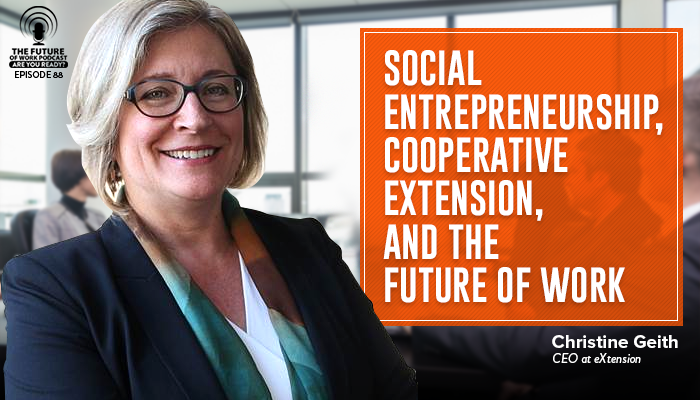Click Here to Subscribe via iTunes
Click Here to Subscribe via RSS Feed (non-iTunes feed)

What is in this episode and what you should care:
Dr. Christine Geith is the CEO at eXtension, which is part of the Cooperative Extension System. She has worked in higher education at two universities, including Michigan State most recently. Her specialty is online learning. About three years ago, Christine got involved in refreshing the conversation about the Cooperative Extension System’s digital strategy and knowledge dissemination to the public,. Her goal is to help the system’s professionals increase their measurable local impact.
The Cooperative Extension System was founded 100 years ago and includes 120 institutions that have different types of funding from the federal government. It is basically a network of people in every county across the United States that is responsible for spreading research based science and innovation to families, communities, and farmers. They share information about food systems, production, family nutrition, solutions for obesity and chronic disease, community prosperity, starting small businesses, protecting and managing natural resources, extreme climate and weather change responses, and more!
Christine believes that the system is America’s best kept secret. It was created by the people, for the people and is the largest informal learning network across the country. There are at least 15,000 people involved in the extension offices that are spread over the US. Different states have different priorities so the role of extension in economic development will be different depending on the goals of each state. The programs that emerge from the Cooperate Extension System create opportunities and evolve as the needs of communities change.
Cooperate extension helps people adopt new ways of living, working, and creating livelihood so prosperity and health are increased across the country. Even after 100 years, the system continues to be a priority funded by the USDA and the states. Agriculture is the root of the system, but not the limit of its scope. Due to the incredible variety of resources that it offers, it remains resilient and adaptable.
- What is cooperative extension
- What are social entrepreneurs
- How is innovation changing for social entrepreneurs
- Comparing the differences in ashoka, singularity, cooperative extension
- Online learning
- Role of communication in innovation
- How to apply these new models in our communities
Links In the Episode:
——————————————————————————-
This podcast is brought to you by Staples Business Advantage, the business-to-business division of Staples, Inc. Is your kitchen, cafe, or lounge area in desperate need of a makeover? You’re in luck! Staples Business Advantage is currently accepting submissions for its Ultimate Breakroom Makeover contest until June 6th. It’s important for organizations to encourage their employees to take a break by providing a well-stocked and inviting breakroom. Find out more about the contest at staplesbreakroomcontest.com.

Jacob – in the podcast you asked me how many employees are in the agriculture and food sector in the U.S. – the answer is: 17.3 million full- and part-time jobs or about 9.3 percent of total U.S. employment. See more at http://www.ers.usda.gov/data-products/ag-and-food-statistics-charting-the-essentials/ag-and-food-sectors-and-the-economy.aspx
This is only one sector of our economy supported by the U.S. Cooperative Extension System – the public education system operated through Land-Grant Universities in partnership with federal, state and local governments.
Extension professionals enable 4-H Youth Development, Agriculture, Family & Consumer Sciences, Health and Nutrition, Community Development, Water and Natural Resources, Forestry, Emergency Preparedness, Climate Variability, Volunteerism, and Human Sciences. Many Cooperative Extension Education Programs are delivered at little or no cost to citizens through public funding.
Listeners can find a Cooperative Extension office or educator near them by going to http://www.csrees.usda.gov/Extension.
To learn about the impact of Cooperative Extension throughout the United States and U.S. territories go to http://landgrantimpacts.org. Cooperative Extension’s unique structure consists of university faculty members and local educators.
eXtension.org is part of the system and supports digital strategies and services for CES professionals and the public they serve.
It was a pleasure being on your podcast! Thanks for your terrific questions and the opportunity to share the unique work of Cooperative Extension nationwide.
– Chris
@christinegeith
Jacob – in the podcast you asked me how many employees are in the agriculture and food sector in the U.S. – the answer is: 17.3 million full- and part-time jobs or about 9.3 percent of total U.S. employment. See more at http://www.ers.usda.gov/data-products/ag-and-food-statistics-charting-the-essentials/ag-and-food-sectors-and-the-economy.aspx
This is only one sector of our economy supported by the U.S. Cooperative Extension System – the public education system operated through Land-Grant Universities in partnership with federal, state and local governments.
Extension professionals enable 4-H Youth Development, Agriculture, Family & Consumer Sciences, Health and Nutrition, Community Development, Water and Natural Resources, Forestry, Emergency Preparedness, Climate Variability, Volunteerism, and Human Sciences. Many Cooperative Extension Education Programs are delivered at little or no cost to citizens through public funding.
Listeners can find a Cooperative Extension office or educator near them by going to http://www.csrees.usda.gov/Extension.
To learn about the impact of Cooperative Extension throughout the United States and U.S. territories go to http://landgrantimpacts.org. Cooperative Extension’s unique structure consists of university faculty members and local educators.
eXtension.org is part of the system and supports digital strategies and services for CES professionals and the public they serve.
It was a pleasure being on your podcast! Thanks for your terrific questions and the opportunity to share the unique work of Cooperative Extension nationwide.
– Chris
@christinegeith